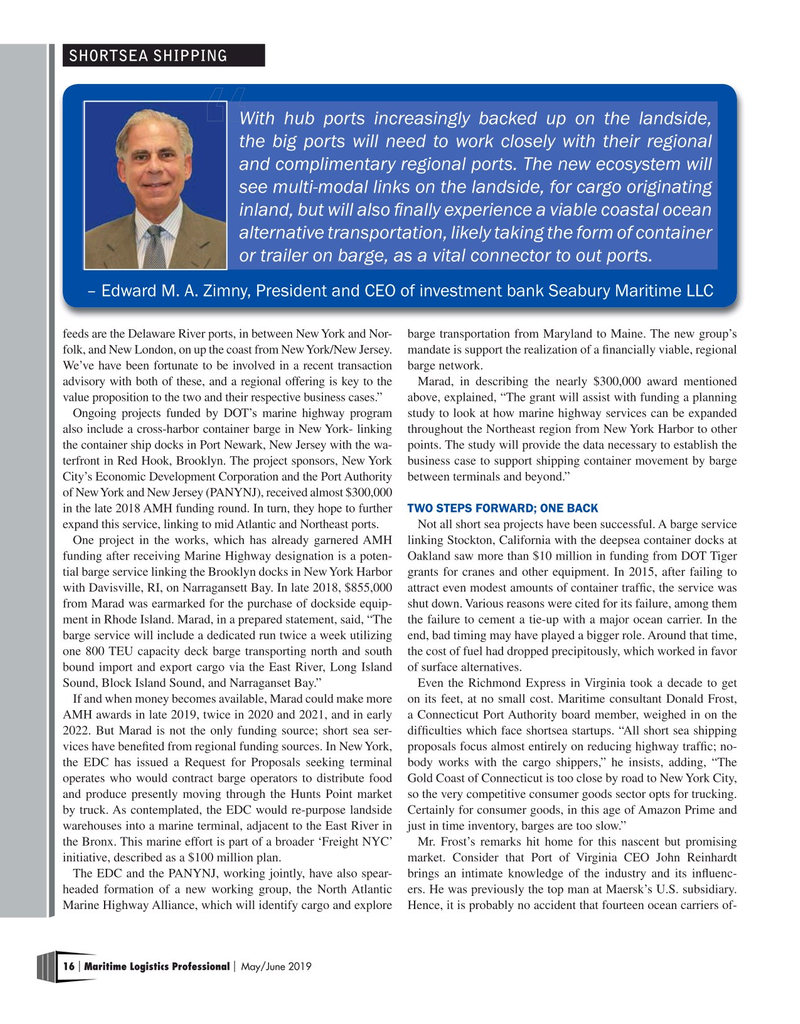
Page 16: of Maritime Logistics Professional Magazine (May/Jun 2019)
US and International Navy Ports
Read this page in Pdf, Flash or Html5 edition of May/Jun 2019 Maritime Logistics Professional Magazine
SHORTSEA SHIPPING
With hub ports increasingly backed up on the landside, the big ports will need to work closely with their regional and complimentary regional ports. The new ecosystem will see multi-modal links on the landside, for cargo originating
LQODQGEXWZLOODOVRÀQDOO\H[SHULHQFHDYLDEOHFRDVWDORFHDQ
DOWHUQDWLYHWUDQVSRUWDWLRQOLNHO\WDNLQJWKHIRUPRIFRQWDLQHU
RUWUDLOHURQEDUJHDVDYLWDOFRQQHFWRUWRRXWSRUWV – Edward M. A. Zimny, President and CEO of investment bank Seabury Maritime LLC feeds are the Delaware River ports, in between New York and Nor- barge transportation from Maryland to Maine. The new group’s folk, and New London, on up the coast from New York/New Jersey. mandate is support the realization of a ?nancially viable, regional
We’ve have been fortunate to be involved in a recent transaction barge network.
advisory with both of these, and a regional offering is key to the Marad, in describing the nearly $300,000 award mentioned value proposition to the two and their respective business cases.” above, explained, “The grant will assist with funding a planning
Ongoing projects funded by DOT’s marine highway program study to look at how marine highway services can be expanded also include a cross-harbor container barge in New York- linking throughout the Northeast region from New York Harbor to other the container ship docks in Port Newark, New Jersey with the wa- points. The study will provide the data necessary to establish the terfront in Red Hook, Brooklyn. The project sponsors, New York business case to support shipping container movement by barge
City’s Economic Development Corporation and the Port Authority between terminals and beyond.” of New York and New Jersey (PANYNJ), received almost $300,000 in the late 2018 AMH funding round. In turn, they hope to further TWO STEPS FORWARD; ONE BACK expand this service, linking to mid Atlantic and Northeast ports. Not all short sea projects have been successful. A barge service
One project in the works, which has already garnered AMH linking Stockton, California with the deepsea container docks at funding after receiving Marine Highway designation is a poten- Oakland saw more than $10 million in funding from DOT Tiger tial barge service linking the Brooklyn docks in New York Harbor grants for cranes and other equipment. In 2015, after failing to with Davisville, RI, on Narragansett Bay. In late 2018, $855,000 attract even modest amounts of container traf?c, the service was from Marad was earmarked for the purchase of dockside equip- shut down. Various reasons were cited for its failure, among them ment in Rhode Island. Marad, in a prepared statement, said, “The the failure to cement a tie-up with a major ocean carrier. In the barge service will include a dedicated run twice a week utilizing end, bad timing may have played a bigger role. Around that time, one 800 TEU capacity deck barge transporting north and south the cost of fuel had dropped precipitously, which worked in favor bound import and export cargo via the East River, Long Island of surface alternatives.
Sound, Block Island Sound, and Narraganset Bay.” Even the Richmond Express in Virginia took a decade to get
If and when money becomes available, Marad could make more on its feet, at no small cost. Maritime consultant Donald Frost,
AMH awards in late 2019, twice in 2020 and 2021, and in early a Connecticut Port Authority board member, weighed in on the 2022. But Marad is not the only funding source; short sea ser- dif?culties which face shortsea startups. “All short sea shipping vices have bene?ted from regional funding sources. In New York, proposals focus almost entirely on reducing highway traf?c; no- the EDC has issued a Request for Proposals seeking terminal body works with the cargo shippers,” he insists, adding, “The operates who would contract barge operators to distribute food Gold Coast of Connecticut is too close by road to New York City, and produce presently moving through the Hunts Point market so the very competitive consumer goods sector opts for trucking. by truck. As contemplated, the EDC would re-purpose landside Certainly for consumer goods, in this age of Amazon Prime and warehouses into a marine terminal, adjacent to the East River in just in time inventory, barges are too slow.” the Bronx. This marine effort is part of a broader ‘Freight NYC’ Mr. Frost’s remarks hit home for this nascent but promising initiative, described as a $100 million plan. market. Consider that Port of Virginia CEO John Reinhardt
The EDC and the PANYNJ, working jointly, have also spear- brings an intimate knowledge of the industry and its in?uenc- headed formation of a new working group, the North Atlantic ers. He was previously the top man at Maersk’s U.S. subsidiary.
Marine Highway Alliance, which will identify cargo and explore Hence, it is probably no accident that fourteen ocean carriers of- 16 Maritime Logistics Professional May/June 2019 | |

 15
15

 17
17
